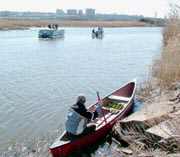Attention feathered travelers looking to rest and refuel – New Jersey has prime real estate for you.
April is the start of spring migration season and, local volunteers have helped the New Jersey Meadowlands Commission staff provide attractive lodging for tree swallows coming to Secaucus.
More than 1,000 new “swallow nest boxes” were installed from Kearny Marsh to Mill Creek Marsh between the first day of spring (March 21) and April 11, including at NJMC headquarters in Lyndhurst.
NJMC Outreach Naturalist Gabrielle Bennett-Meany provided plans and instructions to build boxes throughout winter months to anyone interested in getting involved. Community helpers provided the materials and elbow grease.
Volunteers from schools, civic organizations and other Hudson County residents made the 850 tree swallow boxes, 150 Kestrel boxes, 24 duck boxes, and 6 Purple Martin houses. NJMC staffers placed them in the field.
Weather-damaged nesting areas that were installed last year were also repaired or upgraded. “This is one of the largest conservation projects I work on,” said Bennett-Meany. “I get a lot of deliveries [bird boxes] from Scouts looking for projects to kids looking for a commitment.”
Eating mosquitos
The wooden nesting houses help support species that play necessary roles in the complex food web keeping the Meadowlands a vibrant habitat
Tree swallows are small songbirds with long pointed wings. Their iridescent blue-green plumage is striking next to their thin, white bellies. They fly in wide, swooping circles and are very territorial among themselves.
Besides being fun and beautiful to look at, they do double-duty as pest eaters. Swallows pick their place of migratory residence because of foraging habits. That means they come here for the bugs.
The increased numbers of birds, especially the tree swallow and Purple Martin, devour large quantities of the ever-present mosquito and midge.
“The tree swallow presence helps keeps the bug population down,” says NJMC senior wetlands specialist Kyle Stendiff. “They are their natural predators.”
Stendiff says the swallow houses have a two-fold purpose. Swallows are a tree-dwelling native species. Invasive species such as the European starling and English house sparrow deter them from nesting. By keeping houses available that are of a size and location good for sparrows, the population has a better chance of multiplying.
Crossroad in the flyway
This is a good thing for avid birders in Secaucus. The Garden State is attractive to migratory birds because it lies at a crossroad for the Atlantic Flyway. The flyway extends from offshore waters of the Atlantic Coast to the Allegheny Mountains then on to Canada and Alaska.
Migratory songbirds, shorebirds and other species stop off after their 6,000-mile flight from South America. The paths of migratory animals often cross and concentrate on their way in from points south and west.
Long distance migrants like the Semiplamated sandpiper stop over on their way to the North American Arctic. Medium distance ducks such as Teal and Canvas Back use Mill Creek Marsh as a wintering habitat on their way to the upper Midwest or Arctic northeast. Short-distance migrants such as the gray catbird stay in the Meadowlands on their way from the Gulf States to south Canada.
“It’s really convenient to walk anytime from behind the Stop-and-Shop down one of the trails at Mill Creek – there’s a lot to see,” says birder and Secaucus resident Diane Brin. “Depending on the tide and time of year, you can see a number of different species.”
Brin said she has recently seen a pair of red-tail hawks and a variety of gulls from the trail.
New Jersey’s large population of gulls includes the Herring gull, great black-back gull, ring-billed gull and laughing gull.
The NJMC staff has also placed nesting platforms in Mill Creek Marsh to attract the first nesting pair of ospreys to the Meadowlands in more than 50 years.
